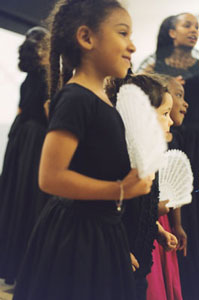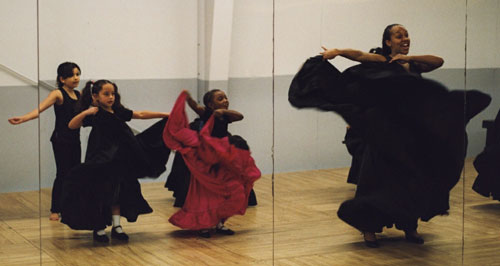Why They Dance
The Importance of Arts and Culture for Puerto Ricans
Story by Brooke Hovey, University of Texas at Austin
Photos by Deepti Mangla, University of Texas at Austin
As America is home to many diverse peoples, arts and cultural
education are perhaps the most meaningful ways in which various
groups stay connected to their own unique heritages. This is also
one of the most effective ways to educate and excite children, in
particular, about their culture. Parents face a difficult task of
educating their children about culture, but by getting them
involved in the arts, they can make the process fun.
Dr. Ana Marķa Maynard, mother of two young children, has dedicated her life to creating a space in which she can share her Puerto Rican heritage through the arts. Her inspiration came after the birth of her first child. Maynard explains that there was no visible Puerto Rican presence in Austin at that time.

"There was very little here for my own people, my own culture, and this wonderful heritage that I grew up in," she says. "Music and dance are a very important part of Puerto Rican culture. There was nowhere in Austin for my son to learn our musical and cultural traditions." Maynard was determined to find a way to educate her children and other Puerto Ricans about their unique island culture. She has done this through education, music, and dance.
In 1997, Maynard founded the Puerto Rican Folkloric Dance and Cultural Center in Austin. The center attempts "to promote cultural awareness and pride through performances and educational programs in the performing arts and culture." The center is a nonprofit organization, and Maynard works on a volunteer basis. The performing company is funded in part by the National Endowment for the Arts, the Texas Commission on the Arts, the Austin Arts Commission, and the Institute of Puerto Rican Culture. In addition to directing the professional-level company of dancers and musicians, Maynard offers classes to all ages, ranging from young children to adults, and all ability levels. She encourages all people to try her classes, with or without dancing experience.
At Puerto Rican Folkloric Dance, Maynard strives to make the experience a family event, in which parents and their children can learn, grow, and celebrate together. In contrast to other dance studios, instructors at PRFD encourage the parents of their students to stay and watch rehearsals and lessons. Maynard explains, "We make it not only a dance and culture class, but a family event. There is a family support structure, and they're all in this together. I don't know what I enjoy more, watching the children learning and loving what they're doing, or watching the parents loving their children."
The classes are held in a small room at Tapestry dance studio off 5th Street. Children and their parents begin to wander in around 9:45 on Saturday morning. In the 15 minutes before class, the room is filled with talk and laughter. A young girl's father helps her tie her skirt, kisses her on the forehead, and then joins the other parents seated on benches around the room. The girl rushes over to her friends who are seated around the instructor, whom they clearly adore. At 10:00, it is time for class to begin. The students rise, spread out around the room, and follow the instructor's lead through a lively warm-up. When the warm-up is complete, students gather around their instructor for the weekly culture lesson. At Puerto Rican Folkloric Dance, every class incorporates a brief lesson in the historical development of Puerto Rico's customs and traditions. The children's lessons provide a glimpse into their heritage that is simple and entertaining. The children clearly enjoy this part of the morning, as do their parents who observe and perhaps learn something new themselves.

Following the lesson, the next hour is spent rehearsing and learning new combinations of traditional Puerto Rican dances - the Bomba, Plena, Seis, and Danza. The music never stops. All feet are light on the wooden floor. The room is filled with energy and excitement. On this particular morning, the children are practicing for their upcoming recital - a chance for them to show off all they have learned.
In creating Puerto Rican Folkloric Dance, Maynard has provided a tremendous service to both children and adults in the community. David and Olga Simons, a couple who moved to Texas from Puerto Rico, wanted to find a way to teach their 8-year-old daughter about her heritage. They enrolled her in the children's classes, and then signed on themselves. "We simply couldn't resist Ana Marķa's enthusiasm," Mrs. Simons said. "I'm amazed by this place. This takes a lot of hard work."
PRFD does require a lot of hard work, time, and dedication, but Maynard believes strongly in the importance of arts and culture. Dr. Arturo Madrid, a professor at Trinity University, has written extensively on this subject (Madrid, 2002). He writes that arts and culture are important for several reasons. First, arts and culture connect us to the past; they enable us to remember, recollect, and recall. Furthermore, arts and culture allow communities to come together and celebrate their values and uniqueness. Finally, arts and culture expression allow diverse peoples to preserve and communicate their culture, so that future generations may share in their heritage.
So when Maynard's young students dance around the room to a traditional Puerto Rican beat, they may not yet realize the significance of their dancing. But their parents and instructors do. Their dancing is the embodiment of a rich cultural tradition they are slowly coming to understand, and will one day pass on to their own children. To them, it's just plain fun, but to Maynard, it's beautiful.
Fall classes for children and teens begin August 17, 2002. For more information about the Puerto Rican Folkloric Dance & Cultural Center, please visit www.prfdance.com or call 251-8122.